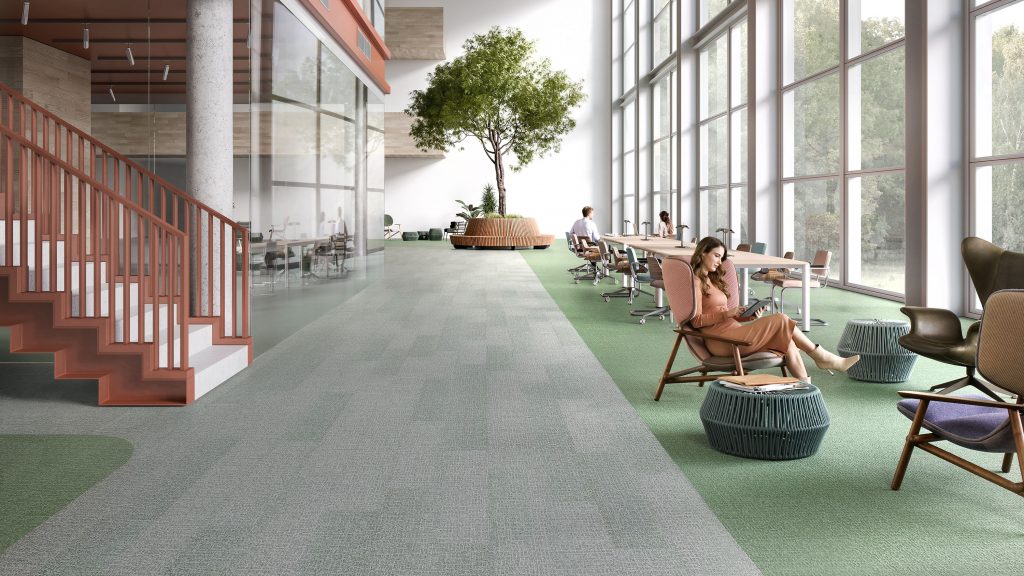Tarkett releases its 2021 Corporate Social & Environmental Report
March 10, 2022

Tarkett has recently set an ambitious climate roadmap for 2030 across its entire value chain[1], aiming to reduce greenhouse gas emissions by 30%. This covers emissions from the Group’s activities (Scope 1) and its purchased energy (Scope 2) – as well as those arising from the rest of its value chain, from suppliers to end customers (Scope 3).
Over the last two years, we have reduced our greenhouse gas emissions[2] by 27% . We now want to go further by setting this ambitious climate roadmap. We build more and more partnerships in circular economy and climate action, making conscious choices for people and the planet. Together with our ecosystem, we are actively contributing to the United Nations Sustainable Development Goals and it is key that we embark on this journey with our customers
Fabrice Barthélemy, CEO of Tarkett
Beyond its ambition to be a game changer with circular economy, the Group is also focusing on using good materials for people’s health and well-being. As part of its social responsibility, Tarkett also protects and develops its teams, creates a culture of diversity and inclusion while supporting its local communities.
Tarkett has reached strong progress with ReStart® , its take-back and recycling program, by transforming end-of-use flooring and recycled materials into new floors. This helps reducing waste and carbon footprint, diminishing the need for virgin raw materials while avoiding landfill and incineration.
In the last 11 years, the company has collected the equivalent of 11 Eiffel Towers (112,000 tons) of flooring as part of its ReStart® program in Europe, North America and Brazil, inside eight recycling centers.
Strong progress in ReStart® has been achieved at the unique carpet recycling center in Waalwijk, Netherlands, the vinyl recycling center in Ronneby, Sweden and the linoleum recycling center in Narni, Italy. Together, these three recycling centers have increased their ReStart® collection by 69% compared to 2019.
In addition to progress made with ReStart® , 15% of Tarkett’s raw materials (147,000 tons) are recycled materials in 2021, the goal is to reach 30% by 2030.
Tarkett has reduced its carbon footprint
- 38% of the total energy consumption comes from renewable energies.
- Greenhouse gas emissions from purchased electricity, steam consumption and fuel combustion at Tarkett’s 34 production sites in 19 countries were reduced by 44% compared to 2010, which corresponds to the annual greenhouse gas emissions of 21,000 Europeans.[3]
- Fossil fuel heating systems have been replaced by electric or biomass powered systems. For example, the plant in Jacareí (Brazil) has changed the energy source of its hot press from natural gas to electricity thus reducing the associated greenhouse emissions. Jacareí now sources 100% renewable electricity from hydroelectric, solar and wind sources.
Recent examples illustrating our CSR performance
- In Sweden and Belgium, we collaborated with IKEA to collect and recycle used flooring from their stores in Stockholm (Sweden) and Arlon (Belgium). Over 14,500 m2 of material was collected and then processed at our on-site recycling facility in Ronneby (Sweden).
- Tarkett is the only carpet manufacturer in Europe capable to fully recycle its commercial carpet tiles, thanks to its unique carpet recycling center in Waalwijk (Netherlands) and in close collaboration with its supplier Aquafil. Recycling 1 m² of post-use EcoBase® carpet tiles flooring waste saves 10 kgCO2e.
- In Europe, we are deploying renewable infill layers to be used in artificial turf. PureMix infill, mixing crushed olive cores with existing cork infill, was deployed at The Hague (Netherlands) municipality football pitch. In Saint-Ouen (France), during the refurbishment of the artificial turf of Red Star football school training ground, recycled and renewable materials were used. An infill comprised of sand recovered from old artificial turf was used along with PureSelect crushed olive cores.
- In Europe, our ProMax HydroFlex sports infill solution – manufactured in Germany – is made of 30% recycled polyethylene sourced from end-of-use artificial turf fields.
- In the USA, we incorporated recycled post-use PVB in our ethos® Modular with Omnicoat Technology™, a high-quality soft surface floor solution made from healthy, safe materials, including 33% post-consumer recycled PVB. From 2004 to 2021, we reused around 37,000 tons of PVB films from 36 million windshields.
- As part of our Tarkett Cares program and in order to support local communities, we involved our teams in over 700 community initiatives, with employees volunteering 3,300 days and over 1 million euros of product donations (2017-2021).
[1] Versus 2019, scope 1, 2 and 3
[2] Scope 1 & 2 GHG emissions compared to 2019
[3] EuroStat reported in 2021 that the total carbon footprint of EU-27 was equal to 6.7 tonnes of CO2 per person in 2019. Tarkett’s 2021 absolute Scope 1 and 2 GHG emissions at production sites represent 177,500 tons CO2e which corresponds to a reduction of more than 140 000 tons CO2e compared to 2010.